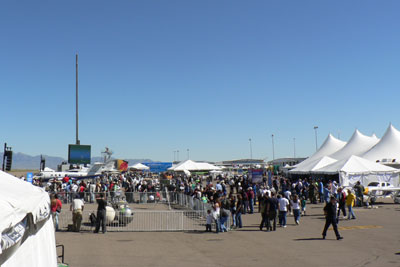X Prize Cup 2006: an appreciationby Alex Howerton
|
| The sense of failure, if there is one, stems from the difference between our expectations and reality. We get impatient; we want to go to space now, and we can’t be bothered to wait until the system actually works. |
The media, being the media, likes to see things blow up or fall short of expectations. Such events make for compelling headlines. However, it is this precise process of testing to failure, testing beyond existing limits, that is necessary to gather the data and build the systems that will work properly, when we need them to work, namely when we’re on board. Two men prominently profiled during the X Prize Cup, Robert Goddard and Wernher Von Braun, failed repeatedly and dramatically before they achieved ultimate success, and what they learned as a result forms the foundation of what we can do now. This is the process of research and development, and it should not be forgotten, nor should it be discounted.
The sense of failure, if there is one, stems from the difference between our expectations and reality. We get impatient; we want to go to space now, and we can’t be bothered to wait until the system actually works. We grew up in an era where immense promises were made to us, about space stations and lunar hotels and cheap access to space, which have not been fulfilled.
Many of the people in the forefront of the NewSpace movement were precisely those kids who grew up hearing those promises, and have now become sick of waiting, and are using their successes in other endeavors to fund their dreams. If you set aside your expectations and look at what they’ve actually done, they’ve been incredibly successful. Burt Rutan and Paul Allen flew SpaceShipOne. John Carmack was out there at X Prize Cup, flying space hardware. Who cares if he didn’t win this year? He and all the rest of them are not going to give up; they will succeed, after numerous but necessary failures, in opening space for the rest of us.
Despite the unfulfilled promises, despite the failures, if you take the Apollo program (a bizarre, anomalous artifact of the Cold War, in retrospect) out of the equation, you will witness steady, increasing progress in space development. We will get to space. We just have to rein in our expectations to manageable proportions. And we have to return to events such as the X Prize Cup, year after year, and continue to build the community and the spirit that will carry us to the stars. That is why you’ll see me at next year’s X Prize Cup. I hope to see you there, too.
